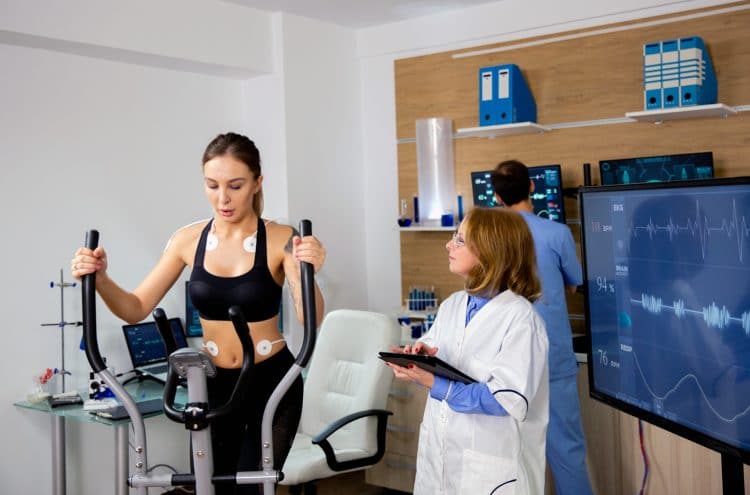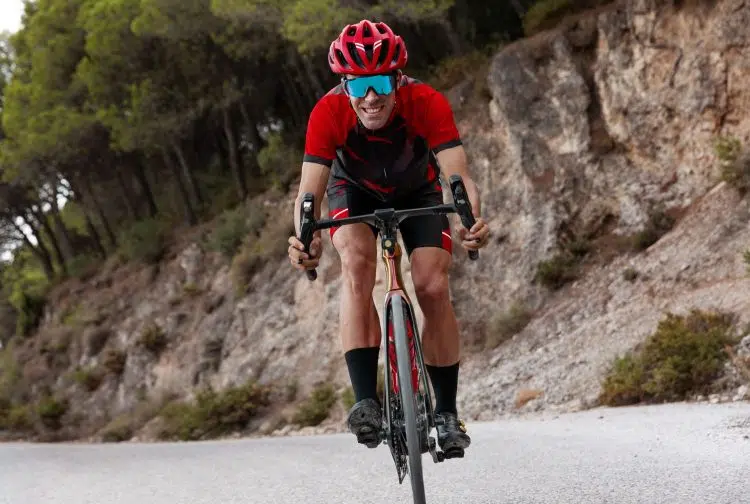As a cyclist, you want to optimize your ride so that every minute in the saddle counts. For that to happen, you’ve got to monitor your heart activity. Knowing your average heart rate while cycling allows you to train within the ideal zone to achieve your goals.
As a personal trainer, I’ve worked with competitive cyclists as well as recreational cyclists. By monitoring their average heart rate while training, they’ve improved their fitness parameters and achieved their goals faster.
In this article, we’ll delve into the nuances of average heart rate while cycling. Here’s what we’ll cover:
- Why monitor average heart rate while cycling
- How to use heart rate monitoring to optimize training
- The best ways to monitor your average heart rate while cycling
The Significance of Average Heart Rate in Cycling
There are some good reasons why it’s worth monitoring your heart rate while cycling. Here are four ways heart rate monitoring can make your training more productive:
Heart Rate Zone Training
Knowing your average heart rate while cycling will allow you to train within a specific heart rate zone. By monitoring your heart rate, you can adjust your pedaling intensity to stay within your target zone.
Level Up Your Fitness: Join our 💪 strong community in Fitness Volt Newsletter. Get daily inspiration, expert-backed workouts, nutrition tips, the latest in strength sports, and the support you need to reach your goals. Subscribe for free!
For example, if your training goal is fat loss, you will want to keep your average rate in zone 2, which requires pedaling at a moderate pace. For endurance, however, you will want to maintain a significantly higher average heart rate.
There are five heart rate training zones, each corresponding to a different level of effort. Each zone is based on a percentage of your maximum heart rate.
The zone heart rate percentages are
- Zone One: 50-60% of Max HR (warm-up )
- Zone Two: 60-70% of Max HR (light pedaling)
- Zone Three: 70-80% of Max HR(medium-paced pedaling)
- Zone Four: 80-90% of Max HR (fast pedaling)
- Zone Five: 90-100% of Max HR (full-speed pedaling)
Cardio Fitness Level
Your average heart rate while cycling is a good indicator of your cardiovascular fitness level. The harder you work on the cycle, the harder your heart has to work to pump blood around your body. Over time, your heart responds to this stress by getting stronger and slightly larger.
A stronger, larger heart can pump more blood efficiently with each beat. At the same time, your workouts are helping you to lose body fat. Every kilogram of fat you carry adds several kilometers of blood vessels to your cardiovascular system.
That means the heart has to work harder to pump blood through the fat cells and down to the legs and arms. When you lose fat, your heart doesn’t have to work as hard, and your average heart rate decreases.
Performance Monitoring
If you are a competitive cyclist, you should use heart rate data to gauge your performance and track your improvements from one workout to the next.
Analyzing your average heart rate data may help you identify trends, strengths, and weaknesses in your performance. You can then use that knowledge to tweak your training program and performance goals.
Health Monitoring:
You can spot abnormalities by monitoring your average heart rate. If your heart rate is consistently very high even though you’re only training moderately, this may indicate some underlying problem. In this case, you may want to seek medical attention.
Conversely, if your average heart rate remains low when you train intensely, this may indicate fatigue, dehydration, or some other health concern requiring attention.
Motivation and Accountability
Tracking your average heart rate while cycling provides tangible data to help gauge your progress. This can increase your motivation, boost your confidence, and help keep you committed to your training regimen.
You increase your accountability when you share your average heart rate data with others, including your coach or members of an online support community.
Variables That Affect Average Cycling Heart Rate
The amount of effort you put into each pedal stroke isn’t the only factor determining your workout heart rate. Four other variables come into play:
Your Age
The older you get, the lower your maximum heart rate becomes. This is because our heart muscles become less elastic and stiff as we age. As a result, the heart is not able to contract as forcefully.
Age-related lower maximum heart rate must be considered when working out your training heart rate zone. The American Heart Association recommends using the following formula to work out your maximum heart rate based on your age:
220 – age
So, a 59-year-old would have a maximum heart rate of 220-59, which comes to 161 beats per minute. Their target heart rate for each zone would be a stated percentage of that maximum.
The following target heart rate zones by age can be used to help set your training goals:
| Age | Target Heart Rate Zone |
| 20-29 | 100-170 bpm |
| 30-39 | 95-162 bpm |
| 40-49 | 90-153 bpm |
| 50-59 | 85-145 bpm |
| 60-69 | 80-136 bpm |
Your Level of Fitness
The fitter you are, the lower your heart rate will be. As you get fitter, you should adjust your heart rate targets in line with your improved cardio fitness level to ensure you’re training at the right intensity. This can be likened to increasing the weight as you get stronger in the gym.
The Workout Terrain
Your workout terrain will affect the intensity of your workout and subsequent demands on your heart. If you have to pedal uphill, your heart will be forced to pump harder than on the flat. On the other hand, downhill cycling will be less taxing.
Your heart rate while pedaling on flat terrain will vary according to the intensity of your pedaling. If you are doing high-intensity interval training, switching between super fast and slow recovery periods, you can get close to your maximum for brief periods of all-out exertion.
Level Up Your Fitness: Join our 💪 strong community in Fitness Volt Newsletter. Get daily inspiration, expert-backed workouts, nutrition tips, the latest in strength sports, and the support you need to reach your goals. Subscribe for free!
The Weather
All you have to do is recall the last time you cycled into a headwind to appreciate how weather can affect cycling. Wind and rain can make the ride more demanding on your cardiovascular system, increasing your heart rate.
Cold weather will cause your blood vessels to vasoconstrict. As a result, the heart has to pump harder to push blood around your body.
Hot, humid conditions can do the same, as the cardio system must work overtime to help cool the body down. Dehydration can also force up the heart rate, so ensure you drink water regularly.
You must factor the weather conditions into your heart rate training plan for the day to avoid overexertion and potential burnout.
Average Cycling Heart Rate Compared to Running

Cycling and running are two of the most popular cardio fitness activities. So, it’s interesting to compare the average heart rate between these two forms of exercise.
A 2009 review published in Sports Medicine explored the physiological differences between cycling and running. The researchers found that, along with increased VO2 Max, runners had a higher average heart rate for both maximal and submaxinal intensities. [1]
There is no standard differential between heart rates when training at the same intensity during a running versus cycling workout. The difference can range from 10 to 25 beats per minute. However, the Sports Journal article recommends reducing your training heart rate target by 10 beats per minute on a cycle to account for this difference.
Let’s look at an example, using zone 2 training for a 48-year-old.
This person’s maximum heart rate will be 172 (220-48).
In zone 2, he will operate at 60-70% of his maximum, which is 103-120 beats per minute. He will now reduce those parameters by 10 calories on either side for a target range of 93 to 110 bets per minute.
How To Measure Your Heart Rate When Cycling
There are several ways to monitor your training heart rate while cycling. Here’s an overview.
Heart Rate Monitor (HRM) Chest Straps
HRM chest straps are considered one of the most accurate methods for measuring heart rate during cycling.
These devices consist of a soft fabric strap worn around the chest, which contains sensors that detect the electrical signals generated by the heart. The strap communicates wirelessly with a compatible cycling computer, smartwatch, or smartphone app, providing real-time heart rate data.
In my experience, chest strap pulse monitors are more reliable and provide continuous monitoring than any other method.
Wrist-Based Heart Rate Monitors
Wrist-based heart monitors are built into most fitness trackers and smartwatches. They have optical heart rate sensors that use light to sense blood volume changes under the skin that correlate to changes in heart rate.
Wrist-based heart rate monitors are popular due to their simplicity of use. But they are nowhere near as accurate as chest strap monitors, especially when vigorous cycling is involved.
Cycling Computers with Heart Rate Sensors
Cycle computer monitors may be compatible with ANT+ or Bluetooth heart rate sensors. These are paired with a chest strap or wrist monitor to display real-time heart rate data on the bike’s monitor. These monitors usually also include a GPS tracker and other performance diagnostics.
Smartphone Apps
Both Android and iOS phones feature optical heart rate sensors. These generally provide low-quality data and may not be accurate enough to monitor your average cycling workout training heart rate accurately. A phone app that pairs with a chest strap via Bluetooth is more reliable.
Pulse Checking
If you prefer to go old school, you can check your pulse manually during rest periods. Do this by putting your index and middle fingers on your wrist and counting the beats for 10 seconds. Multiply this number by six to get your beats per minute.
Checking your pulse manually will not provide real-time feedback while exercising, like in the case of a chest strap monitor, but it can still give you a general picture of what is going on with your heart during your workout.
FAQs
What is considered a normal average heart rate while cycling?
A normal average heart rate while cycling can vary depending on age, fitness level, and cycling intensity. However, for most adults, a typical average heart rate during moderate-intensity cycling ranges from 50% to 70% of their maximum heart rate.
How does cycling intensity affect the average heart rate?
Cycling intensity significantly influences average heart rate. Higher-intensity cycling, such as interval training or hill climbs, increases heart rate as the body works harder to meet the demands of the activity.
Cycling downhill or at a cruising speed will produce a reduced heart rate.
Does average heart rate vary depending on the type of cycling (e.g., road cycling, mountain biking)?
Yes, the type of cycling can influence average heart rate. For example, road cycling on flat terrain typically results in a more consistent and steady heart rate compared to mountain biking, which involves variable terrain and terrain features that can lead to fluctuations in heart rate.
Conclusion
Knowing your average heart rate while cycling will help you:
- Train within the ideal zone for your workout goal.
- Determine whether you are working intensely enough.
- Optimize fat-burning and endurance training.
- Improve your cardio health.
I recommend using a chest strap heart rate monitor for the most accurate average heart rate measurement while cycling.
Check out our heart rate-based calorie burn calculator to determine how many calories your workout consumes.
References
- Millet GP, Vleck VE, Bentley DJ. Physiological differences between cycling and running: lessons from triathletes. Sports Med. 2009;39(3):179-206. doi: 10.2165/00007256-200939030-00002. PMID: 19290675.











The reference to max heart rate is not for athletes but more towards sedentary people. I am a 67 year old ex runner and current cyclist whom still gets max HR of 193.